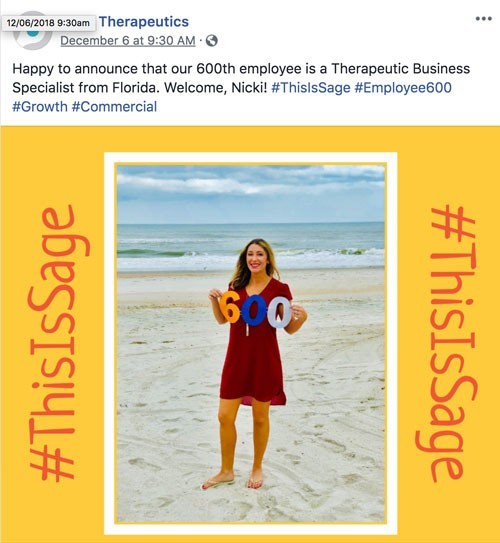Expert Ed Nathanson’s 8 Tips for Building Your Employer Brand — Without Investing Big Bucks
Ed Nathanson is an outspoken champion of the underdog. His signature song is “Gonna Fly Now (Theme from Rocky).” He roots for dark horses because they’re more fun — and because, he says, “they can win.”
So it’s hardly surprising that Ed, the founder of the talent acquisition consultancy Red Pill Talent, works with small- and medium-size businesses around the world. He doesn’t outfit his clients with slingshots to battle corporate Goliaths, but he does provide them with small-budget tactics to elevate their employer brand.
And when it comes to a powerful employer brand, Ed says, “You don’t need to be Google, okay?”
“It’s not about size,” Ed told a Talent Connect 2018 breakout entitled “Build a Compelling Employer Brand Without the Big Bucks.” “It’s not about consumer brand. It’s about effort. It’s about dedication. It’s about doing your homework and about being authentic and understanding the importance of humor and heart.”
Here are Ed’s eight tactics for building an enviable employer brand without ever writing a big check:
1. Start by establishing your employer branding success metrics
Short of running up the steps at the Philadelphia Museum of Art, how can you be Rocky? According to Ed: Start with goals and put metrics in place against each of them.
“When I do this exercise with companies as we set out,” Ed says, “I ask them what they care about. What do you want to get out of it?”
Ed suggests starting with hiring. “That’s why we play the game,” he says. “What are your goals for the year? Can we meet it? Can we exceed it? Can you get ahead of planning for next year?”
Ed recommends creating goals around inbound (people applying to you). He also suggested looking at referrals; outbound recruiter response rate; career site traffic (“hugely important,” Ed says); and social engagement rates (likes, clicks, shares, and comments). Ed also looks at the quality of applicants. “I have a very simple formula,” he says. “It’s people applied versus people who got screened by a recruiter.”
2. Create talent personas based on your best employees
Of course, you want your top candidates and your future hires to be like your best employees. So it pays to understand your standouts.
Ed recommends doing this by pulling together 15 to 30 of your top people. Make sure it’s a diverse group — varied backgrounds, tenures, and ages. “And I ask them lots and lots of questions,” he says. “I have someone there literally taking notes like a court stenographer.”
Some of the things Ed asks his assembled all-stars:
- When you’re looking for a job, what are the things that matter most to you?
- Why did you join the company?
- When you got your offer, what were your apprehensions about joining? (“Here’s where you learn the weak spots,” he says.)
- What social channels are you on? What do you like — movies, TV shows, kicks on the weekend?
He takes what he hears and pours it into word cloud software and then sees what themes bubble up.
3. Develop a content plan that includes channels and frequencies
Storytelling is a vital and effective way to showcase the culture, values, and people at your company. Content, Ed says, should start with a plan, and part of the plan should be figuring out channels and communication cadences — this is weekly, monthly, or one time only. Have a brainstorming session to surface ideas based on what you learned when developing the best-employee personas and on knowing that, regardless of your company size, content can deliver a hefty return on your creative investment. Use those ideas as the baseline for a year-long schedule.
For example, Ed says, clinical-stage medicine maker Sage Therapeutics created social content around its monthly awards for employees who best embody its core values. “Two hundred fifty-six people liked that,” Ed says. “At the time they posted it, they didn’t even have that many employees.”
The personas can also provide direction on what your company should blog about by targeting the thing that your best employees care about. He mentions a CEO who blogged about how his company gives employees Allbirds sneakers on their work anniversaries — people loved reading about how an executive appreciates his employees.
Ed’s single driving principle for content is that it should either have humor or heart. “If it’s not funny or it doesn’t have emotion tied to it,” he says, “nobody cares.”
4. Draft an army of brand ambassadors – and reward them
Clearly, when your employees put the good word in for your company, their participation magnifies your voice and lifts your employer brand. In the 2018 Edelman Trust Barometer, 71% of respondents said that employees were more believable than CEOs. They’re your best brand ambassadors.
But you need to ask. This is what Ed advises saying to your team: “If you feel comfortable, share the world through your lens. Use our hashtag, whatever it is you’re doing. Here are the channels we’re on. If you don’t want to say anything, if you just want to like or share our stuff, it will reach a bigger audience. We’d really appreciate it.”
Ed says you should do more than just ask, however. Hold a contest for, say, the top social share of the quarter that is based on one of your company’s values. Have the CEO announce the winner at an all-hands meeting and give the champ a prize. Or highlight top social sharers on the monitors in your lobby or common areas.
5. Pitch your company’s culture and experts, not just your products and services
“PR is really, really critical,” Ed says. And his first suggestion is to get your PR firm, if you have one, to think more expansively.
“They’re probably out there getting you press opportunities or speaking opportunities or conference opportunities about the product or service,” Ed says. “That’s awesome. But guess what? If you ask them to get you opportunities about hiring, about culture, about people, they’re getting calls every day from publications all around the world about these topics.” Grab these opportunities, he says, and become part of the conversation. Seek out speaking opportunities for all the subject matter experts on your team and, when possible, send them out to present at conferences.
Ed also recommends entering contests that select the best places to work. “There’s nothing better than having that ‘Best Places to Work’ on your website or on your employees’ signatures,” he says. “And you can’t win if you don’t play, right?”
6. Create a career site that makes applying easy and shows what it’s like to work there
Ed believes that your career site is the very heart of your employer brand — and it’s critical to get it right.
Ed suggests this thought experiment: “You’re looking for a car,” he says. “You turn on the TV. Here’s Matthew McConaughey talking pensively while driving his car, ‘Life man.’ Doing his thing. All right? Then you go to the car dealership, and the car looks nothing like what you thought and you’re dealing with a jerk salesperson. One hundred percent of the time you are not going to buy that car.
“Same concept here,” Ed continues. “You put out the you’re fun, exciting, cool, all of those things, and then it gets to your website as a bunch of corporate gobbledygook nonsense. Lots of words and very corporate buttoned up. You’ve lost. It’s over. This is perhaps one of the most important elements of a good employer brand that most companies underestimate mightily.”
A successful career site, as Ed sees it, makes it incredibly easy for candidates to apply for jobs. It will also show more than it tells and will favor images over words. “Show people what it’s like to be there,” Ed says. “It has to match what you’ve been putting out there. That consistency absolutely has to be there.”
7. Leverage free and low-cost tools for building your employer brand
Ed feels strongly that you can’t build a strong employer brand without the right tools.
Some of the tools (free or inexpensive) that Ed finds to be indispensable include:
- Canva — a graphic design app that allows you to create banners, infographics, social updates, and more.
- iMovie — easy, effective way to make videos that can be used as everything from job postings to new-hire welcome messages (more on that in a minute)
- Imgflip — a meme and GIF generator to energize blog and social media posts
- GifJif — an incredible resource you can use to add faces to 4,500 existing GIFs
- Desygner — a design tool for the nondesigner (social posts, flyers, ads, and more)
“Social aggregators,” he says, “now these cost some money, but they’re not expensive.” Tools such as Hootsuite and Buffer collect the content from your different social media channels and give you a single platform from which you can deploy and monitor all of it.
8. Elevate your candidate experience
Ed’s simplest idea for enhancing the candidate experience may be the most counterintuitive: Write your candidates a thank-you note.
“What if you flip it,” he says, “and as soon as a candidate leaves, the manager has to write a personal thank-you note saying, ‘You could have been anywhere today. You took time out of your day to come and interview with us. We’re super thankful you came in.’”
Ed also believes you should bring that level of personalization and gratitude to new hires as well.
One company Ed worked at would send an email that said, “We’re so excited for you to start on Monday. We feel like champions. We made this video just for you.” The team in the clip would lip-dub Queen’s “We Are the Champions.” People who got the video told the company that they knew they had made the right choice.
Other welcoming options, Ed says, include sending a memorable gift to your new hires; a JibJab ecard using their face along with members of the team they’re joining (our featured image above with Ed's face is a little example); or a GIF with current employees holding signs that say, “Welcome Pat.”
Final thoughts: Make sure you craft a plan
Undoubtedly, you have all sorts of innovative ideas for funny, heartwarming social content and video and PR and blog posts that practically write themselves. But there’s still one thing missing.
“You have to have a plan,” Ed says.
“To roll this out effectively,” he adds, “you can’t do it all at once. You need to have a measured plan of where you’re going to focus, how much it’s going to take, what time and resources it’s going to take.”
Employer branding is not about big budgets; it’s about planning, follow-through, and sweat equity. “I don’t care how big or small you are,” Ed says, “if you don’t devote time to it, it won’t work. And if you do, it will.”
Watch Ed's full breakout session below:
*Image from JibJab
To receive blog posts like this one straight in your inbox, subscribe to the blog newsletter.
Topics: Small business Employer brand
Related articles





